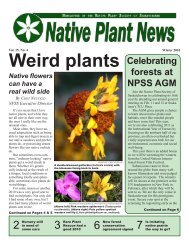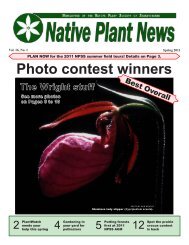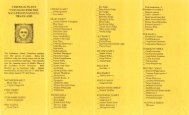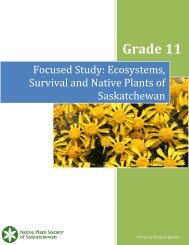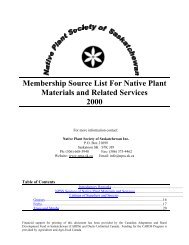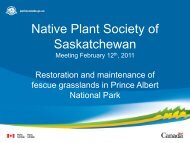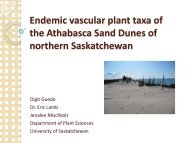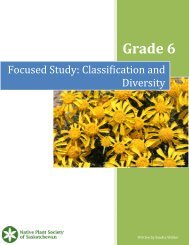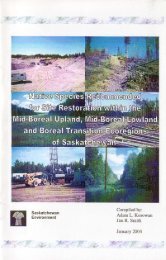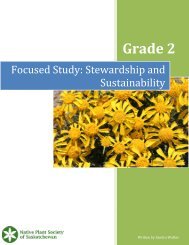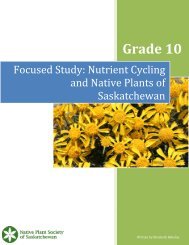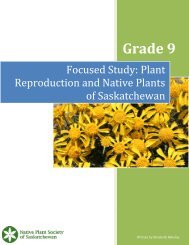Grade 10 Cultural Perspectives Lesson Plan - Native Plant Society ...
Grade 10 Cultural Perspectives Lesson Plan - Native Plant Society ...
Grade 10 Cultural Perspectives Lesson Plan - Native Plant Society ...
Create successful ePaper yourself
Turn your PDF publications into a flip-book with our unique Google optimized e-Paper software.
<strong>Grade</strong> <strong>10</strong><br />
Focused Study: <strong>Cultural</strong><br />
<strong>Perspectives</strong> on Saskatchewan<br />
<strong>Native</strong> <strong>Plan</strong>t Uses<br />
Written by Elizabeth Bekolay
The <strong>Native</strong> <strong>Plan</strong>t <strong>Society</strong> of Saskatchewan is a strong advocate of nature<br />
education.<br />
In addition to this lesson plan, we also support schools by:<br />
- providing free printed resources.<br />
- leading field tours.<br />
- delivering outdoor and classroom presentations.<br />
- hosting opportunities to "ask an expert", where students can interact with a professional biologist or<br />
related occupation though in person events or Skype. In some cases, we can arrange for French<br />
speaking experts.<br />
We also support the establishment of native plant learning gardens on school grounds by offering free<br />
native seeds, printed resources, personal visits, presentations and expert advice to help with all stages<br />
of the process. The gardens can be as small as a square meter.<br />
All of what we do is always free for participating schools.<br />
Does any of this sound like something you'd want If so, please call us at (306) 668-3940 or e-mail us at<br />
info@npss.sk.ca<br />
Free Electronic Resources on the <strong>Native</strong> <strong>Plan</strong>t <strong>Society</strong> of Saskatchewan Website (www.npss.sk.ca)<br />
<br />
<br />
<br />
<br />
A Guide to Small Prairie Restoration - How to Grow Your Own Patch of <strong>Native</strong> Prairie<br />
Saskatchewan's <strong>Native</strong> Prairie: Taking Stock of a Vanishing Ecosystem and Dwindling Resource (Also<br />
available in print)<br />
On the Prairie - A webpage on our site with a "Build a Prairie" game, field guide to prairie plants and<br />
animals, curriculum goodies like a English-Dakota language guide, and virtual reality panoramas of<br />
prairie places<br />
The Watershed Game<br />
Free Printed Materials Available Through the <strong>Native</strong> <strong>Plan</strong>t <strong>Society</strong> of Saskatchewan:<br />
<br />
<br />
<br />
<br />
<strong>Native</strong> <strong>Plan</strong>ts, Water and Us! (Booklet)<br />
<strong>Native</strong> <strong>Plan</strong>ts, Water and Us! (Poster)<br />
<strong>Native</strong> <strong>Plan</strong>t Communities of Saskatchewan (Poster)<br />
<strong>Native</strong> <strong>Plan</strong>t Communities of Saskatchewan (Activity Sheet)
FOCUSED STUDY: CULTURAL PERSPECTIVES ON SASKATCHEWAN NATIVE PLANT<br />
USES<br />
GRADE <strong>10</strong><br />
OVERVIEW AND PURPOSE<br />
To connect science and indigenous knowledge while inquiring about the uses of a specific native plant.<br />
The students will each choose an individual local native plant to study, focusing on the human uses of<br />
that plant. A walk in a local native ecosystem is integral to this study.<br />
A presentation, walk or visit with a traditional knowledge keeper, ethnobotanist or herbalist is also<br />
integral to this study.<br />
By focusing on one plant, instead of many, a relationship can be built between the student and the<br />
plant. As John Muir wrote, ‘When one tugs at a single thing in nature, he finds it attached to the rest of<br />
the world.’ When a child can focus on something in nature, something tangible that holds a story, and<br />
an adult helps to illuminate that story by asking more questions, the child can begin to see the<br />
connections on their own as a revelation of their own exploration. This is the beginning of ecological<br />
literacy.<br />
OUTCOMES AND INDICATORS<br />
SE1 Explore cultural perspectives on sustainability.<br />
Learning Objectives :<br />
1. Examine how various cultures view the relationships between living organisms and their ecosystems.<br />
MATERIALS<br />
<strong>Plan</strong>t identification books/keys (see resources), books on plant uses, the internet (if available), paper<br />
and pencils for drawing, maps of your area to determine accessibility to native ecosystems. Cameras if<br />
you would like to recall plant features for future identification.<br />
Free publications from the <strong>Native</strong> <strong>Plan</strong>t <strong>Society</strong> of Saskatchewan:<br />
<strong>Native</strong> <strong>Plan</strong>ts, Water and Us!<br />
<strong>Native</strong> <strong>Plan</strong>t Communities of Saskatchewan Poster<br />
<strong>Native</strong> <strong>Plan</strong>t Communities of Saskatchewan Placemat<br />
Saskatchewan’s <strong>Native</strong> Prairie: Taking Stock of a Vanishing Ecosystem and Dwindling Resource<br />
INTRODUCTION<br />
By this grade level a student should have a good understanding of what a native plant is. However, it is<br />
always beneficial to reinforce and remind. A plant native or indigenous to Saskatchewan is one that has<br />
evolved here. This means that it was here prior to European contact. <strong>Native</strong> plants are adapted to their<br />
specific climatic zone and soil type. There are both native aquatic plants and terrestrial plants. <strong>Plan</strong>ts<br />
that are not native are considered ‘introduced’ or ‘exotic’. If these introduced species spread rapidly<br />
and out-compete other plants in an ecosystem they are considered ‘invasive’ or sometimes referred to<br />
as ‘noxious weeds’. <strong>Native</strong> plants are part of the biodiversity that help to keep our ecosystems healthy.<br />
They support a vast number of species that have evolved with them in an intricate relationship. The loss<br />
of this biodiversity has an impact throughout the ecosystem resulting in species endangerment and<br />
extinction. It is important to promote a sense of respect through ecological knowledge of place.
Ethnobotany refers to the study of the relationship between people and plants. The indigenous people<br />
of Saskatchewan have traditionally had a deep relationship with the plants that evolved here. The<br />
plants are medicine, food and material for tools and building. Once Europeans settled and began<br />
turning over the soil of the prairies many of the native plants became scarce in farmed areas and<br />
everyone began depending upon what the farmers could grow on the land. There is now less than 20%<br />
of native prairie left in Saskatchewan. The people of the forests in Saskatchewan did not lose as much<br />
of their biodiversity as the southern tribes.<br />
The plants your class will explore are determined by your geographic location. Enjoy this study with<br />
your students.<br />
INSTRUCTIONAL METHODS<br />
This is a guided inquiry. Do not collect whole plants for this study. Leaf collection may be helpful for<br />
identification. Many close-up photos of each plant and plant part are extremely helpful for<br />
identification.<br />
An excellent way to start is to have an elder or traditional knowledge keeper speak with your students<br />
about plants in the classroom or on a walk. Ensure to follow proper cultural protocol when requesting<br />
the help of an elder. Seek advice from your school division if you are unsure of where to start. For the<br />
cultural protocol of offering tobacco:<br />
http://www.tobaccowise.com/cms/One.aspxportalId=44644&pageId=46570.<br />
Please talk with local people as uses of plants, and the plants themselves, may vary between geographic<br />
locations in Saskatchewan. It is your hope that your students will choose a plant that is native and not<br />
introduced. Before going on your hike study some of the plant species that have been introduced to<br />
Saskatchewan. Make it clear to them that all grain crops and common garden vegetables are<br />
introduced. Here are some others they should be aware of:<br />
Smooth Brome<br />
Dandelion (Not native but edible and very medicinal)<br />
White and Yellow Clover<br />
Alfalfa<br />
Leafy Spurge<br />
There are many more. Here is a list of invasive plants and animals:<br />
http://www.biodiversity.sk.ca/Docs/InvasiveSpecies.pdf<br />
Saskatchewan Weed Control Act plant list (located on page 2397 of the document):<br />
http://www.saskinvasives.ca/file/Saskatchewan%20Gazette%20Dec%20<strong>10</strong>%2020<strong>10</strong>%20-<br />
%20Weed%20List.pdf<br />
Bring your students to a local native ecosystem. In some areas of the province this will take more effort.<br />
Use this fact as part of your teaching strategy. Why are there so few natural areas left in the southern<br />
parts of the province (See resources – Saskatchewan’s <strong>Native</strong> Prairie: Taking Stock of a Vanishing<br />
Ecosystem and Dwindling Resource – free publication from the <strong>Native</strong> <strong>Plan</strong>t <strong>Society</strong> of Saskatchewan).<br />
Have each student sketch or photograph the habitat and choose a specific plant to study. Make sure<br />
that there is enough time for this process, don’t rush them. Give them a chance to roam and sit for a<br />
while. Ask them all to choose different plants, as much as possible.
The proper identification of the plant is important. This is the part of the inquiry the students may need<br />
the most help with. Ensure that they understand the possibility to select a new plant if they are not able<br />
to identify or find information on the first one they choose. Grasses are much more difficult to identify<br />
than wild flowers, shrubs or trees. They can do this after the field trip by choosing one out of a plant<br />
guide or from the internet. Seek resources to help your students; a biologist, a herbalist, a<br />
knowledgeable parent or community member, books from the resource list, an interpretive/nature<br />
center and the internet.<br />
Knowing which ecozone you are studying will really help to narrow the possibilities of species in the<br />
search for your plant’s identity.
http://esask.uregina.ca/entry/ecozones_and_ecoregions.html<br />
Find your ecozone. Are you in<br />
the Prairie, Boreal Plain, Boreal<br />
Shield or Taiga Shield ecozone<br />
Locate your ecoregion to<br />
narrow your plant ID search.
Some botanical terminology may help your students understand the plant identification keys and plant<br />
descriptions:<br />
Chart of leaf morphology characteristics. Source: http://en.wikipedia.org/wiki/File:Leaf_morphology.svg<br />
Image credit: McSush/Debivort
Raceme Spike Corymb<br />
Umbel Panicle Catkin<br />
Chart of common inflorescence (flower) types. Source: http://en.wikipedia.org/wiki/Inflorescense<br />
Image credit: Amanda44, Shazz and Daniel Miłaczewski
Once their plant is properly identified ask them to gather the following information. The information<br />
compiled on their plant should be shared in a way that is interesting to the student. This could be done<br />
in the form of a story, a poem, an essay, or a poster. Ask them to seek out the following information in<br />
their writing:<br />
Latin name (look up the meaning of the Latin names).<br />
Common names (there is often a clue to the plant’s use in the common names that it is given).<br />
The name in a local indigenous language.<br />
Food uses.<br />
Tool uses.<br />
Cultures or groups that depended on this plant, their worldview and how this affected their sense of<br />
place. How did they value the land Why<br />
Stories associated with the plant.<br />
Proper protocol in plant uses.<br />
INQUIRY<br />
Explore, observe, investigate, acknowledge sources, interpret, plan, and create.<br />
Questions: (These are not the essential questions to be answered; they are to help the teacher and<br />
students to explore the possibilities of what can be learned about their plant).<br />
Who used this plant Did more than one culture use this plant How would they collect it When<br />
would they collect it What protocol was appropriate for collecting this plant How do these cultures<br />
perceive plants and our relationships to plants What is this plant used for today<br />
How do you show respect for plants when using them in ceremony or as medicine What is meant by<br />
‘The Standing People'<br />
What does the habitat of this plant look like Is it dry loving, sun loving, or moist and shade loving Do<br />
you think animals use this plant as food and medicine too Which animals might use this plant<br />
ASSESSMENT<br />
Have the students share their research with each other in small groups. Invite community members to<br />
be involved in the presentations. Display the student research in a location where other students from<br />
your school can learn from it.<br />
RESOURCES<br />
Books:<br />
Aikenhead, G. and H. Michell. 2011. Bridging Cultures: Indigenous and Scientific Ways of Knowing<br />
Nature. Pearson Canada. Toronto.<br />
Belcourt, C. 2003. Medicines to Help Us: Traditional Métis <strong>Plan</strong>t Use. Gabriel Dumont Institute.<br />
Saskatoon.<br />
Grant, T. and Littlejohn, G. 20<strong>10</strong>. Greening School Grounds: Creating Habitats for Learning. New<br />
<strong>Society</strong> Publishers. Gabriola Island.
Hammermeister, A., D. Gauthier and K. McGovern. 2001. Saskatchewan’s <strong>Native</strong> Prairie: Taking Stock<br />
of a Vanishing Ecosystem and Dwindling Resource. <strong>Native</strong> <strong>Plan</strong>t <strong>Society</strong> of Saskatchewan. Saskatoon.<br />
Johnson, D., L. Kershaw, A. MacKinnon, and J. Pojar. 1995. <strong>Plan</strong>ts of the Western Forest: Alberta,<br />
Saskatchewan & Manitoba Boreal Forest & Aspen Parkland. Lone Pine Publishing and the Canadian<br />
Forest Service. Edmonton.<br />
Keane, K. and D. Howarth. 2003. The Standing People: Field Guide of Medicinal <strong>Plan</strong>ts of the Prairie<br />
Provinces. Root Woman and Dave. Saskatoon.<br />
Lahring, H. 2003. Water and Wetland <strong>Plan</strong>ts of the Prairie Provinces. Canadian Plains Research Center.<br />
Regina.<br />
MacKinnon, A., J. Arnason and L. Kershaw. 2009. Edible and Medicinal <strong>Plan</strong>ts of Canada. Lone Pine<br />
Publishing. Edmonton.<br />
Saskatchewan Indian <strong>Cultural</strong> Centre. 2009. <strong>Cultural</strong> Teachings: First Nations Protocols and<br />
Methodologies. Available through the Saskatchewan Indian <strong>Cultural</strong> Centre:<br />
http://www.sicc.sk.ca/index.html<br />
Saskatchewan Indian <strong>Cultural</strong> Centre. 2009. Practicing the Law of Circular Interaction. First Nations<br />
Environmental & Conservation Principles Binder. Available through the Saskatchewan Indian <strong>Cultural</strong><br />
Centre: http://www.sicc.sk.ca/index.html<br />
Savage, C. 2012. A Geography of Blood: Unearthing Memory From a Prairie Landscape. Greystone<br />
Books. Vancouver.<br />
Savage, C. 2011. Prairie: A Natural History. Greystone Books. Vancouver.<br />
Vance, F.R. et al. 1999. Wildflowers Across the Prairies. Greystone Books. Vancouver.<br />
Wruck, G. and K. Gerein. 2003. <strong>Native</strong> <strong>Plan</strong>ts, Water and Us! <strong>Native</strong> <strong>Plan</strong>t <strong>Society</strong> of Saskatchewan.<br />
Saskatoon.<br />
Websites:<br />
The <strong>Native</strong> <strong>Plan</strong>t <strong>Society</strong> of Saskatchewan<br />
http://www.npss.sk.ca/<br />
Saskatchewan Indian <strong>Cultural</strong> Centre<br />
http://www.sicc.sk.ca/index.html<br />
The Standing Ones<br />
http://www.manataka.org/page15.html<br />
University of Saskatchewan Herbarium Rare <strong>Plan</strong>ts Index<br />
http://www.usask.ca/biology/rareplants_sk/root/htm/en/index.php/
Ethnobotany of two Cree Communities in the Southern Boreal Forest of Saskatchewan<br />
http://ecommons.usask.ca/handle/<strong>10</strong>388/etd-08<strong>10</strong>2009-134148<br />
Saskatchewan Archeological <strong>Society</strong><br />
http://www.saskarchsoc.ca/resources-teaching-archaeology-in-schools-2/<br />
A List of Books on Herbal Medicines<br />
http://www.forestshop.com/MEDICINE.html<br />
Gabriel Dumont Institute<br />
http://www.metismuseum.ca/media/document.php/11389.pdf<br />
Master’s Thesis on Cree Forest Terminology<br />
http://creeculture.academia.edu/KevinBrousseau/Papers/287201/Cree_Forest_Lexicon_Final_Report<br />
People and Sites to visit in Saskatchewan if you need guidance with your study:<br />
PROVINCE WIDE<br />
Chet Neufeld with the <strong>Native</strong> <strong>Plan</strong>t <strong>Society</strong> of Saskatchewan. (info@npss.sk.ca or 306-668-3940).<br />
http://www.npss.sk.ca/<br />
SOUTH<br />
A local elder or wise community botanist/herbalist<br />
Saskatoon<br />
Beaver Creek Conservation Area http://www.meewasin.com/education/beaver_creek/<br />
Wanuskewin - http://www.wanuskewin.com/<br />
Val Marie<br />
Grasslands National Park http://www.pc.gc.ca/pn-np/sk/grasslands/index.aspx<br />
CENTRAL<br />
A local elder or wise community botanist/herbalist<br />
North Battleford<br />
Allen Sapp Healing Garden http://www.allensapp.com/about/<br />
Prince Albert<br />
Nature Prince Albert http://www.natureprincealbert.ca/<br />
Waskesiu<br />
Prince Albert National Park http://www.pc.gc.ca/pn-np/sk/princealbert/index.aspx<br />
Batoche<br />
http://www.pc.gc.ca/eng/lhn-nhs/sk/batoche/index.aspx
NORTH<br />
A local elder or wise community botanist/herbalist<br />
Saskatchewan Archaeological <strong>Society</strong>:<br />
http://www.saskarchsoc.ca/wp-content/uploads/2012/07/Athabasca_Region.pdf<br />
http://www.saskarchsoc.ca/wp-content/uploads/2012/07/Churchill_River.pdf<br />
References:<br />
Johnson, D., L. Kershaw, A. MacKinnon, and J. Pojar. 1995. <strong>Plan</strong>ts of the Western Forest: Alberta,<br />
Saskatchewan & Manitoba Boreal Forest & Aspen Parkland. Lone Pine Publishing and the Canadian<br />
Forest Service. Edmonton.<br />
Wruck, G. and K. Gerein. 2003. <strong>Native</strong> <strong>Plan</strong>ts, Water and Us! <strong>Native</strong> <strong>Plan</strong>t <strong>Society</strong> of Saskatchewan.<br />
Saskatoon.<br />
This project was undertaken with the financial support of:<br />
Ce projet a été réalisé avec l'appui financier de:



